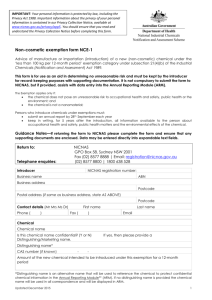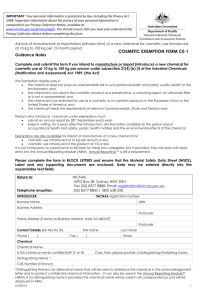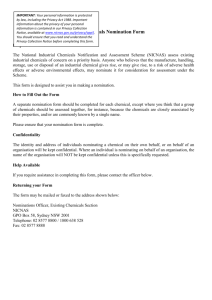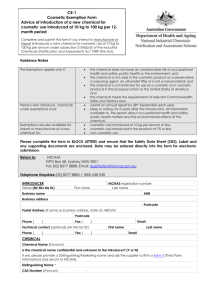Controlled Use Permit (Form CUP-1)
advertisement
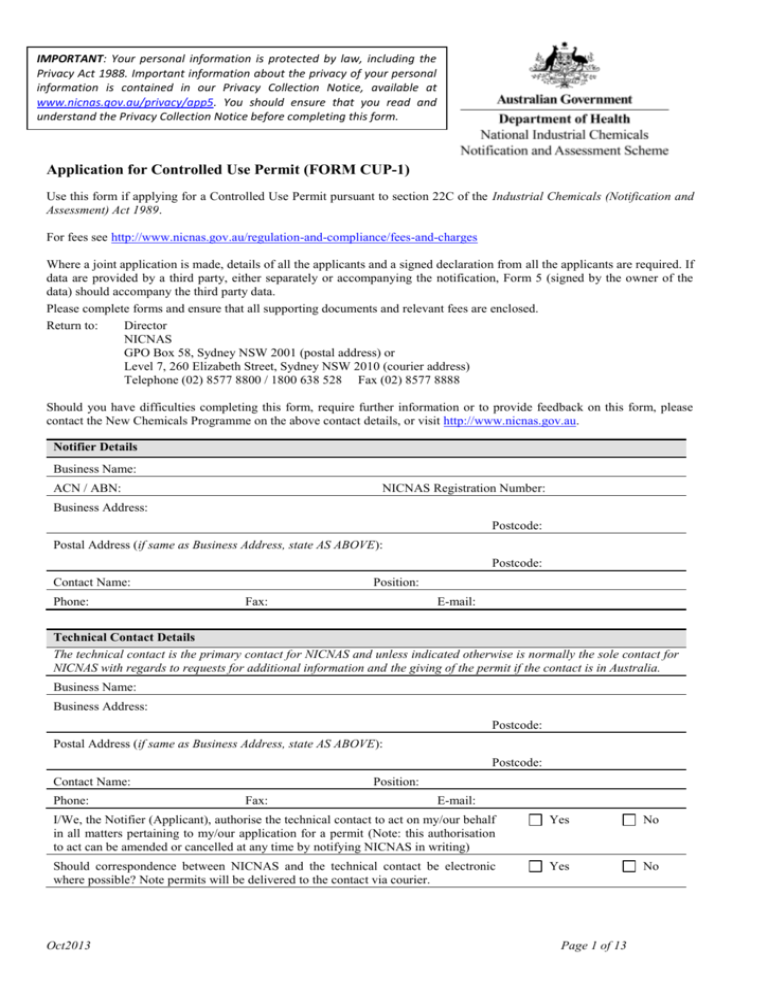
IMPORTANT: Your personal information is protected by law, including the Privacy Act 1988. Important information about the privacy of your personal information is contained in our Privacy Collection Notice, available at www.nicnas.gov.au/privacy/app5. You should ensure that you read and understand the Privacy Collection Notice before completing this form. Application for Controlled Use Permit (FORM CUP-1) Use this form if applying for a Controlled Use Permit pursuant to section 22C of the Industrial Chemicals (Notification and Assessment) Act 1989. For fees see http://www.nicnas.gov.au/regulation-and-compliance/fees-and-charges Where a joint application is made, details of all the applicants and a signed declaration from all the applicants are required. If data are provided by a third party, either separately or accompanying the notification, Form 5 (signed by the owner of the data) should accompany the third party data. Please complete forms and ensure that all supporting documents and relevant fees are enclosed. Return to: Director NICNAS GPO Box 58, Sydney NSW 2001 (postal address) or Level 7, 260 Elizabeth Street, Sydney NSW 2010 (courier address) Telephone (02) 8577 8800 / 1800 638 528 Fax (02) 8577 8888 Should you have difficulties completing this form, require further information or to provide feedback on this form, please contact the New Chemicals Programme on the above contact details, or visit http://www.nicnas.gov.au. Notifier Details Business Name: ACN / ABN: NICNAS Registration Number: Business Address: Postcode: Postal Address (if same as Business Address, state AS ABOVE): Postcode: Contact Name: Phone: Position: Fax: E-mail: Technical Contact Details The technical contact is the primary contact for NICNAS and unless indicated otherwise is normally the sole contact for NICNAS with regards to requests for additional information and the giving of the permit if the contact is in Australia. Business Name: Business Address: Postcode: Postal Address (if same as Business Address, state AS ABOVE): Postcode: Contact Name: Phone: Position: Fax: E-mail: I/We, the Notifier (Applicant), authorise the technical contact to act on my/our behalf in all matters pertaining to my/our application for a permit (Note: this authorisation to act can be amended or cancelled at any time by notifying NICNAS in writing) Yes No Should correspondence between NICNAS and the technical contact be electronic where possible? Note permits will be delivered to the contact via courier. Yes No Oct2013 Page 1 of 13 Chemical Details Chemical Name: Marketing or Other Name(s): CAS Number (if known): Has this chemical been notified overseas? Yes No Yes No Is the chemical an industrial nanomaterial under the NICNAS definition? (Note: for the working definition please consult the NICNAS Handbook for Notifiers) Yes Unsure# No If yes or unsure, is the chemical introduced as a solid/powder or as a dispersion? (Note: if the answer to this question is yes, please consult the above nanomaterial guidance document as additional data requirements may apply). Yes No If so by which competent authority and in what year? Has this chemical been assessed, or is it currently being assessed by another Australian regulatory agency (e.g. TGA, APVMA)? If yes, provide details: #Please note that by checking this box, the chemical may be assumed to be an industrial nanomaterial for risk assessment purposes. Exempt Information Do you wish to claim the chemical name, introduction volume or details of use as being confidential? (fee applies)* Yes No If yes, specify items and provide justification for claims: #For information regarding fees see http://www.nicnas.gov.au/regulation-and-compliance/fees-and-charges Third Party Information Lodgement Does this submission include third party information to be held confidential from the notifier? Yes No If yes, complete and submit a Form 5 (Third Party Information Lodgement) Declaration I declare that to the best of my knowledge all the information in this application is true, correct and complete. In relation to the notification statement and/or other documentation accompanying this application, I declare that I am entitled to use and give the Director all data in the statement. Name Position Signature Date Note: It is an offence under the Act to supply a statement that is false or misleading. Oct2013 Page 2 of 13 Payment Details Please quote Notification number / Registration number / Invoice number when making the payment Electronic Transfer Funds Account Name Department of Health Official Departmental NICNAS Special Account Bank Reserve Bank of Australia, London Circuit, Canberra ACT 2600 BSB Number 092-009 11608-5 Account Number Mastercard Visa Credit card no. Credit Card Amount: $ Expiry Date: Print Name: Authorised Signature: Enclosed Cheque Yes No Cheques are to be made payable to the National Industrial Chemicals Notification and Assessment Scheme (NICNAS) in $AUD. Please note: If payment is being made from an overseas bank, all bank charges/fees are payable by the payee. Applications will not be processed until correct payment has been received. Oct2013 Page 3 of 13 Controlled Use Permit Notification Template (Electronic Submission) The template should be filled out completely. Any missing information may result in delays in processing the application. The completed application should be submitted to NICNAS in both hardcopy and electronic form. Highlighted headings in the form have associated guidance material inserted as comments, which may be seen by holding the mouse cursor over the highlighted area. The guidance material indicates what information should be included in each section. Please note that this document is protected as a form (this allows completion of check boxes). Once the check boxes have been completed, additional functions (e.g. tracked changes or printing the document without the comments visible) may be enabled by removing the document protection via the forms toolbar. The NICNAS Handbook for Notifiers is available from the NICNAS website and should be consulted for additional information. Requirements for toxicological/ecotoxicological data: All available toxicological/ecotoxicological data should be summarised in this application. Where a structural alert exists for a certain human health endpoint e.g. sensitisation, then data (test data, literature data, read across data, modelled data) are required to demonstrate that the chemical or polymer is eligible for the Controlled Use Permit. Data (test data, literature data, read across data, modelled data) are required for each environmental hazard criterion to demonstrate that the chemical or polymer is eligible for the Controlled Use Permit. Other studies may be required where they are deemed necessary to determine no unreasonable risk. Provision of original studies to NICNAS: For introduction volumes exceeding 10 tonnes per year, copies of all available toxicological and ecotoxicological data must be provided with the application. Otherwise, original data should only be provided to NICNAS where a structural alert exists for this endpoint. However, NICNAS may request copies of original data where deemed necessary to determine no unreasonable risk. Down-stream users A chemical introduced under a CUP can be supplied to down-stream users. However, the down-stream user and their practices must be known. The application should provide a description of the operations at the proposed users site. The notifier is responsible for ensuring that this description is accurate. Only those users whose details have been provided to NICNAS can use the chemical (these users will be listed on the permit). NICNAS must be satisfied that the user of the chemical is aware of the conditions of the permit, i.e. that the use is highly controlled. Oct2013 Page 4 of 13 CONTROLLED USE PERMIT ELIGIBILITY CHECKLIST Complete the following checklist to determine eligibility for a Controlled Use Permit. Each of the following criteria must be met. See the Handbook for Notifiers for more information on these criteria. Supporting information to demonstrate criteria should be included in this template. Criterion Criterion met? 1. Occupational exposure Any worker exposure that is likely to occur will be Yes No highly controlled through use of engineering controls, work practices and personal protective equipment 2. Public exposure There are no exposures to consumers or the general Yes No public inherent in the proposed manufacturing, processing or uses of the substance 3. Human health hazard Not classified* as hazardous with any of the classification following Risk phrases: R23, R24, R25, R26, R27, R28, R34, R35, R39, R40, R42, R43, R45, R46, R48, R49, R60, R61, R62, R63, R64 or R68 Toxicity to fish, aquatic invertebrate and algae > 10 mg/litre Ambient release to surface water results in concentrations < 1ppb Ambient release to air < 1mg/m3 average annual concentration There is no release to land or landfill 4. Aquatic toxicity 5. Environmental release to water 6. Environmental release to air 7a. Environmental release to land/landfill Yes No Yes No Yes No Yes No Yes No If no, please address Question 7b. Yes No 7b. Environmental release to The chemical has negligible potential for migration land/landfill to groundwater * In accordance with the Approved Criteria for Classifying Hazardous Substances 3 rd edition [NOHSC:1008(2004)]) Preferred name 1. APPLICANT AND NOTIFICATION DETAILS EXEMPT INFORMATION (SECTION 75 OF THE ACT) [Delete as appropriate] No details that are to be published are claimed exempt from publication. Data items and details claimed exempt from publication: Chemical Name Introduction Volume Details of Use Has this chemical been notified overseas? Has this chemical been assessed previously by NICNAS? Has this chemical been assessed, or is it currently being assessed by another Australian Regulatory Agency? (e.g. TGA, APVMA) If yes, provide details: 2. No No No IDENTITY OF CHEMICAL CHEMICAL NAME Confidential/non-confidential Delete as appropriate OTHER NAME(S) Not for publication CUP/ Yes Yes Yes Page 5 of 13 MARKETING NAME(S) CAS NUMBER Not for publication MOLECULAR FORMULA Not for publication STRUCTURAL FORMULA Not for publication [Free Space for Structural Formula] MOLECULAR WEIGHT ..Da Not for publication MOLECULAR WEIGHT (COMPLETE FOR POLYMERS ONLY) Number Average Molecular Weight (Mn) Weight Average Molecular Weight (Mw) % of MW Species < 1000 Da % of MW Species < 500 Da SPECTRAL DATA Not for publication ..Da ..Da % % Not for publication ANALYTICAL METHOD AND REMARKS TEST FACILITY 3. COMPOSITION DEGREE OF PURITY …% Not for publication HAZARDOUS IMPURITIES/RESIDUAL MONOMERS [If none write ‘None’ here. Otherwise complete boxes below.] [Copy and paste this box as needed.] Chemical Name CAS No. Hazardous Properties Weight % POLYMER CONSTITUENTS Chemical Name CAS No. Weight % starting Weight % residual 4. PHYSICAL/CHEMICAL PROPERTIES Complete all sections for which information is available for the notified chemical. Particular endpoints may be necessary to demonstrate that the Controlled Use Permit criteria have been met. Where a physico-chemical property is required to demonstrate that the Controlled Use criteria are met then this test report should be supplied, otherwise, test reports need not be supplied. NICNAS may request copies of original data for endpoints where classification as a dangerous good may be appropriate. CUP/ Page 6 of 13 Appearance at 20°C and 101.3 kPa Melting Point/Glass Transition Temp Boiling Point Density …°C … kg/m3 at …°C (Note: units are kg/m3; density in kg/m3 is 1000 x density in g/cm3) … kPa at 25oC (or 20oC) … g/L at 20°C Vapour pressure Water Solubility (Include a brief description of the test, including the method used) Hydrolysis as a Function of pH Partition Coefficient (n-octanol/water) Absorption/Desorption Dissociation Constant (delete if no acid or base groups are present) Particle Size (delete if liquid or solution) Flash Point Autoignition Temperature Flammability Explosive Properties Reactivity Degradation Products t½ = … at pH … (shortest t½) Log Pow = … at 20oC Log Koc = … at 20oC pKa = … …oC at … kPa (open cup/closed cup) …oC Yes/No Yes/No e.g. Stable under normal conditions of use. e.g. None under normal conditions of use. Comments on the physical and chemical properties Discuss particularly physico-chemical hazards such as flammability, explosive properties and reactivity. 5. INTRODUCTION AND USE INFORMATION MODE OF INTRODUCTION OF NOTIFIED CHEMICAL FOR THE DURATION OF THE PERMIT (INCLUDING TRANSPORTATION AND PACKAGING) CONCENTRATION DETAILS INTRODUCTION VOLUME OF NOTIFIED CHEMICAL Year 1 Tonnes Confidential Tonnes Non-confidential USE Confidential USE Non-Confidential 2 3 For publication; this field is compulsory and must contain sufficient information to identify industry category and use scenarios. CONTROLLED USE SCENARIO Please tick one of the below boxes if the proposed use of the chemical fits into either of the low exposure scenarios: Containment and controlled reformulation Site limited and closed system Other (NOTE: other use scenarios may meet the criteria set out in the checklist above. However, for such other uses it is preferred that Industry work with NICNAS to develop additional exposure scenarios.) For more information on the human and environmental exposure criteria and two controlled use scenarios which have been developed see the NICNAS Handbook for Notifiers. NOTE: The information detailed below should demonstrate that the Controlled Use Permit criteria are met. IDENTITY OF DOWN-STREAM USERS CUP/ If claimed confidential provide generic text Page 7 of 13 OPERATION DESCRIPTION [Free space for process flow diagram (where available)] PRECAUTIONS TAKEN FOR SAFE TRANSPORT PRECAUTIONS TAKEN FOR SAFE STORAGE 6. OCCUPATIONAL EXPOSURE OCCUPATIONAL EXPOSURE Number and Category of Workers Category of Worker Not for publication Number Exposure Duration (hours per day) Exposure Frequency (days per year) EXPOSURE DETAILS AND CONTROL MEASURES EMPLOYED TO PREVENT EXPOSURE TO WORKERS EMERGENCY PROCEDURES – OCCUPATIONAL 7. PUBLIC EXPOSURE Not for publication CONTROL MEASURES USED TO PREVENT EXPOSURE TO THE PUBLIC 8. HUMAN HEALTH EFFECTS INFORMATION Not for publication LIST OF TOXICOLOGY DATA AVAILABLE SUMMARY OF THE CHEMICAL’S HEALTH EFFECTS Acute toxicity. Irritation and Sensitisation. Repeated Dose Toxicity (sub acute, sub chronic, chronic). Genotoxicity. SUMMARY OF HOW THE CHEMICAL MEETS THE DEFINITION OF A HAZARDOUS SUBSTANCE. JUSTIFICATION FOR READ ACROSS DATA Page 8 of 13 9. ENVIRONMENTAL RELEASE Not for publication RELEASE OF CHEMICAL AT SITE AND CONTROL MEASURES USED TO PREVENT RELEASE TO THE ENVIRONMENT RELEASE OF CHEMICAL FROM USE AND CONTROL MEASURES USED TO PREVENT RELEASE TO THE ENVIRONMENT RELEASE OF CHEMICAL FROM DISPOSAL RELEASE OF CHEMICAL TO SURFACE WATER RELEASE OF CHEMICAL TO AIR RELEASE OF CHEMICAL TO LAND EMERGENCY PROCEDURES – ENVIRONMENTAL 10. ENVIRONMENTAL FATE/EFFECTS INFORMATION Not for publication LIST OF ECOTOXICOLOGY DATA AVAILABLE Summary of the chemicals environmental effects Result Fish toxicity Daphnia toxicity Algal toxicity EC50 … mg/L EC50 … mg/L EC50 … mg/L Effects Observed?1 Other (describe): Other (describe): Yes Yes Yes Yes Yes No No No No No Data Source (e.g. study, read across, journal, model) 1 briefly discuss any observed effects in a few sentences below. Discussion of any effects observed: JUSTIFICATION FOR READ ACROSS DATA PBT CHARACTERISTICS Page 9 of 13 11. MSDS AND LABEL Label A copy of the proposed label(s) for the chemical in the form(s) that is intended to be introduced should be attached to this application. The label should be compiled in accordance with the NOHSC National Code of Practice for the Labelling of Workplace Substances. Label Checklist Signal word eg ‘hazardous’ or ‘warning’ (where appropriate) Ingredient disclosure for Type I hazardous ingredient Risk and Safety phrases, if hazardous Australian contact details Information on label consistent with information detailed in MSDS If hazardous, does label refer to MSDS Material Safety Data Sheet A copy of the MSDS for the chemical and the chemical in the form(s) that is intended to be introduced should be attached to this application. Where reformulation of the chemical occurs in Australia by the notifier (or known other parties) and the chemical is required to be disclosed on the MSDS (either by its full chemical name or generic name), then MSDS for those products should also be attached. The MSDS should be compiled in accordance with the NOHSC National Code of Practice for the Preparation of Material Safety Data Sheets. MSDS Checklist Permit statement (i.e. permit granted under 21U of the Act) Australian contact details Hazardous statement on MSDS Risk and Safety phrases, if hazardous Ingredient disclosure for Type I hazardous ingredient Information on MSDS consistent with information detailed on label Page 10 of 13 Attachment 1 – Optional Template for toxicological information Acute oral toxicity Acute dermal toxicity Acute inhalation toxicity Skin irritation/ corrosion Eye irritation Skin sensitisation Structural alert? Yes Yes Yes Yes Yes Yes No No No No No No Data available? Yes Yes Yes Yes Yes Yes No No No No No No Yes Yes Yes Yes Yes Yes No No No No No No NA NA NA NA NA NA Data Source (e.g. study, read across, journal, model) Effects observed? Result (if study conducted) LD50 … mg/kg bw LD50 … mg/kg bw LC50 … mg/L/4 hour irritating/sligh tly irritating/nonirritating irritating/sligh tly irritating/nonirritating evidence/no evidence of sensitisation NA = not applicable, i.e. study not conducted Bacterial mutagenicity In vitro genotoxicity In vivo genotoxicity Repeat Dose toxicity Developmental/ Reproductive toxicity Carcinogenicity Structural alert? Yes Yes Yes Yes Yes Yes No No No No No No Data available? Yes Yes Yes Yes Yes Yes No No No No No No Yes Yes Yes Yes Yes Yes No No No No No No NA NA NA NA NA NA Data Source (study, read across, journal, model) Effects observed? Result (if study conducted) positive/negativ e/ equivocal positive/nega tive/ equivocal positive/nega tive/ equivocal NOEL/NOA EL/ LOAEL = NOEL/NOAEL / LOAEL = NA = not applicable, i.e. study not conducted Acute Oral Toxicity Dose Number mg/kg bw of Animals Mortality Signs of toxicity Page 11 of 13 Acute Dermal Toxicity Dose Number mg/kg bw of Animals Mortality Acute Inhalation Toxicity Concentration <units> Nominal Actual Eye Irritation Scores Lesion Signs of local toxicity Number and Sex of Animals Mean score* Animal no. 1 2 Signs of systemic toxicity Mortality Maximum Score Signs of toxicity Maximum Duration of Any Effect Maximum Value at End of Observation Period 3 Conjunctiva: redness Conjunctiva: chemosis Conjunctiva:discharge Corneal opacity Iridial inflammation *Calculated on the basis of the scores at 24, 48, and 72 hours for EACH animal. Skin Irritation Scores Lesion Mean Score* Animal no. 1 2 3 Maximum Value Maximum Duration of Any Effect Maximum Value at End of Observation Period Erythema/Eschar Oedema *Calculated on the basis of the scores at 24, 48, and 72 hours for EACH animal. Skin Sensitisation Scores Guinea Pig Test (GPMT or Buehler) Group Challenge Concentration Number of Animals Showing Any Skin Reactions after: 1st challenge 2nd challenge 24 h 48 h 24 h 48 h Test Group Control Group OR Local Lymph Node Assay (LLNA) Concentration (% w/w) Test Substance 0 (vehicle control) Proliferative response (DPM/lymph node) Stimulation Index (Test/Control Ratio) Positive Control Page 12 of 13 Repeat Dose Toxicity Bacterial Mutagenicity In Vitro Genotoxicity In Vivo Genotoxicity Page 13 of 13
